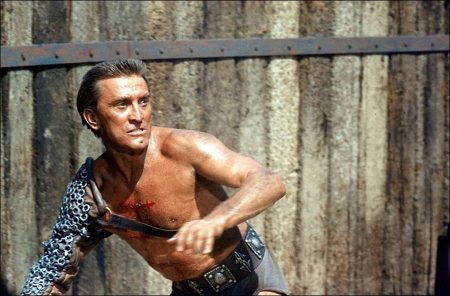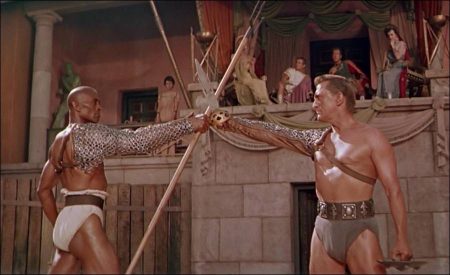Taglines: They trained him to kill for their pleasure. . .but they trained him a little too well.
Spartacus movie storyline. In 73 B.C., a Thracian slave leads a revolt at a gladiatorial school run by Lentulus Batiatus (Sir Peter Ustinov). The uprising soon spreads across the Italian Peninsula involving thousand of slaves. The plan is to acquire sufficient funds to acquire ships from Silesian pirates who could then transport them to other lands from Brandisium in the south.
The Roman Senator Gracchus (Charles Laughton) schemes to have Marcus Publius Glabrus (John Dall), Commander of the garrison of Rome, lead an army against the slaves who are living on Vesuvius. When Glabrus is defeated his mentor, Senator and General Marcus Licinius Crassus (Sir Laurence Olivier) is greatly embarrassed and leads his own army against the slaves. Spartacus and the thousands of freed slaves successfully make their way to Brandisium only to find that the Silesians have abandoned them. They then turn north and must face the might of Rome.
Spartacus is a 1960 American epic historical drama film directed by Stanley Kubrick, written by Dalton Trumbo, and based on the 1951 novel of the same title by Howard Fast. It is inspired by the life story of Spartacus, the leader of a slave revolt in antiquity, and the events of the Third Servile War. It stars Kirk Douglas in the title role, Laurence Olivier as Roman general and politician Marcus Licinius Crassus, Peter Ustinov, who won an Academy Award for Best Supporting Actor, as slave trader Lentulus Batiatus, John Gavin as Julius Caesar, Jean Simmons as Varinia, Charles Laughton as Sempronius Gracchus, and Tony Curtis as Antoninus.
The film won four Academy Awards and became the biggest moneymaker in Universal Studios’ history, until it was surpassed by Airport (1970). In 2017, it was selected for preservation in the United States National Film Registry by the Library of Congress as being “culturally, historically, or aesthetically significant.”
Filming Spartacus
After David Lean turned down an offer to direct, Spartacus was to be directed by Anthony Mann, then best known for his Westerns such as Winchester ’73 and The Naked Spur. Douglas fired Mann at the end of the first week of shooting, in which the opening sequence in the quarry had been filmed. “He seemed scared of the scope of the picture,” wrote Douglas in his autobiography; yet a year later Mann would embark on another epic of similar size, El Cid.
The dismissal (or resignation) of Mann is mysterious since the opening sequences, filmed at Death Valley, Nevada, set the style for the rest of the film.[13] Large parts of the film were shot at Wildwood Regional Park in Thousand Oaks, California. Parts were also filmed at nearby California Lutheran University, where an army can be seen storming off Mount Clef Ridge.
Thirty-year-old Stanley Kubrick was hired to take over. He had already directed four feature films (including Paths of Glory, also starring Douglas). Spartacus was a bigger project by far, with a budget of $12 million (equivalent to approximately $105 million in today’s funds) and a cast of 10,500, a daunting project for such a young director. Paths of Glory, his previous film, had only been budgeted at $935,000.

Spartacus was filmed using the 35 mm Super 70 Technirama format[22] and then blown up to 70 mm film. This was a change for Kubrick, who preferred using the standard spherical format. This process allowed him to achieve ultra-high definition and to capture large panoramic scenes. Kubrick had wanted to shoot the picture in Rome with cheap extras and resources, but Edward Muhl, president of Universal Pictures, wanted to make an example of the film and prove that a successful epic could be made in Hollywood itself and “stem the flood of ‘runaway’ producers heading for Europe”.
A compromise was reached by filming the intimate scenes in Hollywood, and the battle scenes, at Kubrick’s request, in Spain. Kubrick found working outdoors or in real locations to be distracting; he believed the actors would benefit more from working on a sound stage, where they could fully concentrate. To create the illusion of the large crowds that play such an essential role in the film, Kubrick’s crew used three-channel sound equipment to record 76,000 spectators at a Michigan State – Notre Dame college football game shouting “Hail, Crassus!” and “I’m Spartacus!”
The battle scenes were filmed on a vast plain outside Madrid. Eight thousand trained soldiers from the Spanish infantry were used to double as the Roman army. Kubrick directed the armies from the top of specially constructed towers. However, he eventually had to cut all but one of the gory battle scenes, due to negative audience reactions at preview screenings. So precise was Kubrick, that even in arranging the bodies of the slaughtered slaves he had each “corpse” assigned with a number and instructions.
Disputes broke out during the filming. Cinematographer Russell Metty, a veteran with experience working in big pictures such as Orson Welles’ The Stranger (1946) and Touch of Evil (1958) and Howard Hawks’s Bringing Up Baby (1938), complained about Kubrick’s unusually precise and detailed instructions for the film’s camerawork and disagreed with Kubrick’s use of light. On one occasion he threatened to quit to Ed Muhl, to which Kubrick told him: “You can do your job by sitting in your chair and shutting up. I’ll be the director of photography.” Metty later muted his criticisms after winning the Oscar for Best Cinematography. Kubrick wanted to shoot at a slow pace of two camera set-ups a day, but the studio insisted that he do 32; a compromise of eight had to be made. Kubrick and Trumbo fought constantly over the screenplay. Kubrick complained that the character of Spartacus had no faults or quirks.
Despite the film being a huge box office success, gaining four Oscars, and being considered to rank among the very best of historical epics, Kubrick later distanced himself from it. Although his personal mark is a distinct part of the final picture, his contract did not give him complete control over the filming, the only occasion he did not exercise such control over one of his films.
Spartacus (1960)
Directed by: Stanley Kubrick
Starring: Kirk Douglas, Laurence Olivier, Jean Simmons, Charles Laughton, Peter Ustinov, John Gavin, Tony Curtis, Nina Foch, John Ireland, Charles McGraw, Joanna Barnes, Harold J. Stone
Screenplay by: Dalton Trumbo
Production Design by: Alexander Golitzen, Roger K. Furse
Cinematography by: Russell Metty
Film Editing by: Robert Lawrence
Costume Design by: Valles, William Ware Theiss
Set Decoration by: Russell A. Gausman, Julia Heron
Art Direction by: Eric Orbom
Music by: Alex North
MPAA Rating: None.
Distributed by: Universal International
Release Date: October 6, 1960 (New York City)
Views: 472


